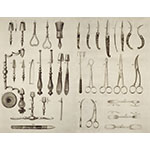The eighteenth-century surgeon was no longer a barber or phlebotomist (bloodletter). He had become a man of science, skill, and experience. This role required new qualities: culture, a knowledge of the latest operating techniques, and proficiency with more refined surgical instruments. The new instruments had to be used more rationally; they were selected and manufactured to serve in specific operating procedures. They were now made of steel, sometimes brass, combined with wood, glass, and rubber. The design remained elegant, with ivory or tortoiseshell handles—but the instruments were lighter and easier to handle. This facilitated the surgeon's task, at a time when manual work, dexterity, and speed were increasingly required for operating in the precarious conditions due to the total lack of narcosis and asepsis.
Giovanni Alessandro Brambilla (1728-1800) commissioned the surgical instruments kit from the cutler Joseph Malliard or Maliar (1748-1814), supplying him with models that included not only French and English instruments, but also the tables of his own Instrumentarium chirurgicum militare Austriacum—a precious source that attests to the progress in surgical instrumentation in the eighteenth century, published in German in 1780 and in Latin in 1782. The collection was donated by Peter Leopold, Grand Duke of Tuscany (1747-1792), to the Arcispedale di Santa Maria Nuova of Florence in 1785, two years after having reformed its charter as well as that of the school of surgery associated with the hospital.








